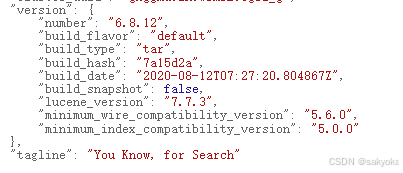前言
最近有用到搜索引擎的功能,这不得把之前的es过程实践一遍,但发现过程坎坷,因为版本太低了。
一、安装es 6.8.12
安装过程跟之前写那章日常记录:elasticsearch 在linux安装_elasticsearch linux安装-CSDN博客一样,安装包下载Elasticsearch 6.8.12 | Elastic。
下载完毕,上传到服务器之后直接用tar -zxvf 解压。然后进入config目录,编辑elasticsearch.yml文件。
======================== Elasticsearch Configuration =========================
NOTE: Elasticsearch comes with reasonable defaults for most settings.
Before you set out to tweak and tune the configuration, make sure you
understand what are you trying to accomplish and the consequences.
The primary way of configuring a node is via this file. This template lists
the most important settings you may want to configure for a production cluster.
Please consult the documentation for further information on configuration options:
https://www.elastic.co/guide/en/elasticsearch/reference/index.html
---------------------------------- Cluster -----------------------------------
Use a descriptive name for your cluster:
cluster.name: es
------------------------------------ Node ------------------------------------
Use a descriptive name for the node:
node.name: master
#cluster.initial_master_nodes: ["master"]
discovery.type: single-node
Add custom attributes to the node:
#node.attr.rack: r1
----------------------------------- Paths ------------------------------------
Path to directory where to store the data (separate multiple locations by comma):
path.data: /home/elasticsearch-6.8.12/to/data
Path to log files:
path.logs: /home/elasticsearch-6.8.12/to/logs
----------------------------------- Memory -----------------------------------
Lock the memory on startup:
#bootstrap.memory_lock: true
Make sure that the heap size is set to about half the memory available
on the system and that the owner of the process is allowed to use this
limit.
Elasticsearch performs poorly when the system is swapping the memory.
---------------------------------- Network -----------------------------------
Set the bind address to a specific IP (IPv4 or IPv6):
network.host: 0.0.0.0
Set a custom port for HTTP:
#http 请求端口
http.port: 9200
#通讯端口
transport.tcp.port: 9300
For more information, consult the network module documentation.
--------------------------------- Discovery ----------------------------------
#discovery.type: zen
#discovery.zen.minimum_master_nodes: 1
Pass an initial list of hosts to perform discovery when new node is started:
The default list of hosts is ["127.0.0.1", "[::1]"]
#discovery.zen.ping.unicast.hosts: ["host1", "host2"]
Prevent the "split brain" by configuring the majority of nodes (total number of master-eligible nodes / 2 + 1):
#discovery.zen.minimum_master_nodes:
For more information, consult the zen discovery module documentation.
---------------------------------- Gateway -----------------------------------
Block initial recovery after a full cluster restart until N nodes are started:
#gateway.recover_after_nodes: 3
For more information, consult the gateway module documentation.
---------------------------------- Various -----------------------------------
Require explicit names when deleting indices:
#action.destructive_requires_name: true
#开启登录校验,不开启登录的话两个都关闭掉
xpack.security.enabled: true
xpack.security.transport.ssl.enabled: true
配置完毕之后,进入es 的bin 目录执行./elasticsearch -d 后台挂起启动。
然后需要初始化一次es密码,执行命令./elasticsearch-setup-passwords interactive 会提示每个账号的密码输入,这里简单输入123456。
好了,在浏览器访问9200,提示账号、密码登录,输入就可以了


这样就简单设置账号登录成功了
二、程序上连接
springboot maven引入spring-boot-starter-data-elasticsearch ,跟随springboot版本,这里springboot版本是2.2.5,自动引入elasticsearch 3.2.5
...
<dependency>
<groupId>org.springframework.boot</groupId>
<artifactId>spring-boot-starter-data-elasticsearch</artifactId>
</dependency>
...
yml配置
spring:
application:
name: es
data:
elasticsearch:
#这里填真实cluster-name名字
cluster-name: es
#这里填真实 cluster-nodes ip+端口
cluster-nodes: xxxx:9300
rest:
uris: http://xxx:9200
username: elastic
password: 123456
这里很坑的是springboot不会自动读取es 账号密码,尝试过yml多动配置账号、密码,最终还是没生效(但是我看es 7.x的springboot是会读取的,知道的同学可以说下),然后自己写一个配置类读取账号、密码 。
package com.xxxxx.configuration;
import org.apache.http.HttpHost;
import org.apache.http.auth.AuthScope;
import org.apache.http.auth.UsernamePasswordCredentials;
import org.apache.http.client.CredentialsProvider;
import org.apache.http.impl.client.BasicCredentialsProvider;
import org.elasticsearch.client.RestClient;
import org.elasticsearch.client.RestClientBuilder;
import org.elasticsearch.client.RestHighLevelClient;
import org.springframework.beans.factory.annotation.Value;
import org.springframework.context.annotation.Bean;
import org.springframework.context.annotation.Configuration;
import org.springframework.data.elasticsearch.config.AbstractElasticsearchConfiguration;
import org.springframework.data.elasticsearch.core.ElasticsearchRestTemplate;
/**
*
* 描述:elasticsearch配置
* @author sakyoka
* @date 2024年10月11日 下午3:47:19
*/
@Configuration
public class ElasticsearchConfiguration extends AbstractElasticsearchConfiguration {
@Value("${spring.data.elasticsearch.rest.username}")
private String username;
@Value("${spring.data.elasticsearch.rest.password}")
private String password;
@Value("${spring.data.elasticsearch.rest.uris}")
private String uris;
@Bean
public ElasticsearchRestTemplate elasticsearchRestTemplate(RestHighLevelClient client) {
return new ElasticsearchRestTemplate(elasticsearchClient());
}
@Override
public RestHighLevelClient elasticsearchClient(){
//这句关闭很奏效,不然会有异常
System.setProperty("es.set.netty.runtime.available.processors", "false");
CredentialsProvider credentialsProvider = new BasicCredentialsProvider();
credentialsProvider.setCredentials(AuthScope.ANY, new UsernamePasswordCredentials(username, password));
RestClientBuilder builder = RestClient.builder(HttpHost.create(uris))
.setHttpClientConfigCallback(http -> {
return http.setDefaultCredentialsProvider(credentialsProvider);
});
return new RestHighLevelClient(builder);
}
}这里es自定义类主要是继承了AbstractElasticsearchConfiguration,重写elasticsearchClient,对RestHighLevelClient设置账号、密码以及请求地址。本来以为重写这个就可以了的,但是提示引用
ElasticsearchTemplate有问题,没错es有两个ElasticsearchRestTemplate以及ElasticsearchTemplate,似乎重写了elasticsearchClient之后一定要用ElasticsearchRestTemplate,所以得重新定义elasticsearchRestTemplate。
好了到目前为止,配置完毕,使用ElasticsearchRestTemplate也正常请求es数据。但是还知道我开启了登录xpack.security.enabled: true同时开启了xpack.security.transport.ssl.enabled: true了吗,这里服务器日志一直打印异常
io.netty.handler.codec.DecoderException: io.netty.handler.ssl.NotSslRecordException: not an SSL/TLS record: 45530000002c00000000000012f208004d3603000016696e7465726e616c3a7463702f68616e647368616b650004bb91f302(已处理日常记录:es TransportClient添加证书处理-CSDN博客)
尝试设置transport的证书,发现还是继续报这个异常,都怀疑生成证书是不是无效的,到目前为止还没解决这个异常,很奇怪的是正常使用,或者这个异常是es节点之间通讯用的?
尝试关闭xpack.security.transport.ssl.enabled: false,但是启动失败至少需要配置证书
xpack.security.transport.ssl.key: ssl/http.key
xpack.security.transport.ssl.certificate: ssl/http.crt
xpack.security.transport.ssl.verification_mode: certificate
关闭之后以及配置这个证书之后,服务器确实不报错了,但是程序报错也不影响使用,一直提示ElasticsearchSecurityException: missing authentication token for action,这个异常问题也没处理,想到这还是让服务器报异常算了,选择开启xpack.security.transport.ssl.enabled: true
以上问题还没处理。。
最后:
1、没有开启登录时候还好好的,啥异常都没有
2、开启登录之后,程序读取不到账号密码,导致需要写配置类,按道理springboot集成es有默认配置,但是网上太多版本、太多配置,没有一个符合的。
3、es证书生成是否有效目前成谜,一直报异常(已处理日常记录:es TransportClient添加证书处理-CSDN博客)